货银第十四章纸质练习(附答案)
第13、14章课后习题答案
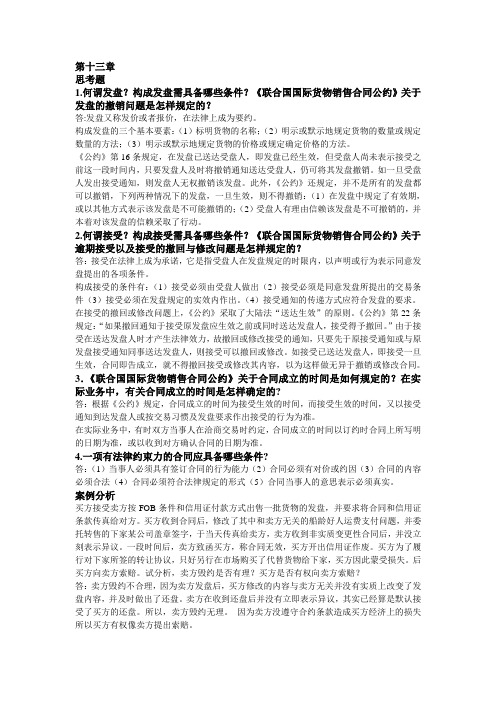
思考题1.何谓发盘?构成发盘需具备哪些条件?《联合国国际货物销售合同公约》关于发盘的撤销问题是怎样规定的?答:发盘又称发价或者报价,在法律上成为要约。
构成发盘的三个基本要素:(1)标明货物的名称;(2)明示或默示地规定货物的数量或规定数量的方法;(3)明示或默示地规定货物的价格或规定确定价格的方法。
《公约》第16条规定,在发盘已送达受盘人,即发盘已经生效,但受盘人尚未表示接受之前这一段时间内,只要发盘人及时将撤销通知送达受盘人,仍可将其发盘撤销。
如一旦受盘人发出接受通知,则发盘人无权撤销该发盘。
此外,《公约》还规定,并不是所有的发盘都可以撤销,下列两种情况下的发盘,一旦生效,则不得撤销:(1)在发盘中规定了有效期,或以其他方式表示该发盘是不可能撤销的;(2)受盘人有理由信赖该发盘是不可撤销的,并本着对该发盘的信赖采取了行动。
2.何谓接受?构成接受需具备哪些条件?《联合国国际货物销售合同公约》关于逾期接受以及接受的撤回与修改问题是怎样规定的?答:接受在法律上成为承诺,它是指受盘人在发盘规定的时限内,以声明或行为表示同意发盘提出的各项条件。
构成接受的条件有:(1)接受必须由受盘人做出(2)接受必须是同意发盘所提出的交易条件(3)接受必须在发盘规定的实效内作出。
(4)接受通知的传递方式应符合发盘的要求。
在接受的撤回或修改问题上,《公约》采取了大陆法“送达生效”的原则。
《公约》第22条规定:“如果撤回通知于接受原发盘应生效之前或同时送达发盘人,接受得予撤回。
”由于接受在送达发盘人时才产生法律效力,故撤回或修改接受的通知,只要先于原接受通知或与原发盘接受通知同事送达发盘人,则接受可以撤回或修改。
如接受已送达发盘人,即接受一旦生效,合同即告成立,就不得撤回接受或修改其内容,以为这样做无异于撤销或修改合同。
3.《联合国国际货物销售合同公约》关于合同成立的时间是如何规定的?在实际业务中,有关合同成立的时间是怎样确定的?答:根据《公约》规定,合同成立的时间为接受生效的时间,而接受生效的时间,又以接受通知到达发盘人或按交易习惯及发盘要求作出接受的行为为准。
《国际货运代理实务》课后练习参考答案
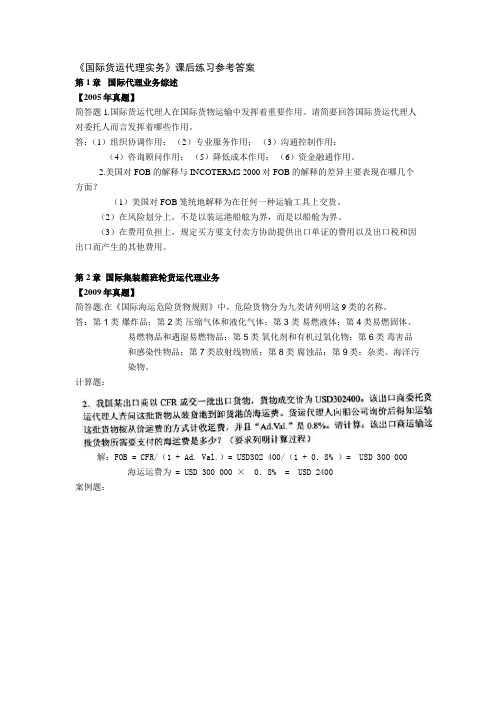
《国际货运代理实务》课后练习参考答案第1章国际代理业务综述【2005年真题】简答题1.国际货运代理人在国际货物运输中发挥着重要作用。
请简要回答国际货运代理人对委托人而言发挥着哪些作用。
答:(1)组织协调作用;(2)专业服务作用;(3)沟通控制作用;(4)咨询顾问作用;(5)降低成本作用;(6)资金融通作用。
2.美国对FOB的解释与INCOTERMS 2000对FOB的解释的差异主要表现在哪几个方面?(1)美国对FOB笼统地解释为在任何一种运输工具上交货。
(2)在风险划分上,不是以装运港船舷为界,而是以船舱为界。
(3)在费用负担上,规定买方要支付卖方协助提供出口单证的费用以及出口税和因出口而产生的其他费用。
第2章国际集装箱班轮货运代理业务【2009年真题】简答题.在《国际海运危险货物规则》中,危险货物分为九类请列明这9类的名称。
答:第1类爆炸品;第2类压缩气体和液化气体;第3类易燃液体;第4类易燃固体、易燃物品和遇湿易燃物品;第5类氧化剂和有机过氧化物;第6类毒害品和感染性物品;第7类放射线物质;第8类腐蚀品;第9类:杂类、海洋污染物。
计算题:解:FOB = CFR/(1 + Ad. Val.)= USD302 400/(1 + 0.8% )= USD 300 000 海运运费为 = USD 300 000 ×0.8% = USD 2400案例题:1.答:(1)A应承担赔偿责任。
因为它与B公司的租船合同已经成立,对于其解除合同的声明,B公司并没同意。
(2)货主不应当承担赔偿责任。
因为货主是跟A公司签订的运输合同,它并没有违约。
(3)应赔偿20万元人民币。
3.答:(1)A公司的货损应向C船公司索赔。
因A公司提货时发现集装箱是空的,且铅封已经被替换过,而C船公司签发了多式联运提单,为多式联运经营人,应对全程负责,所以A应向C船公司索赔。
(2)D铁路公司要承担责任。
D公司作为陆路区段的实际承运人,在其承运期间出现货物丢失,故应承担连带责任。
货银习题
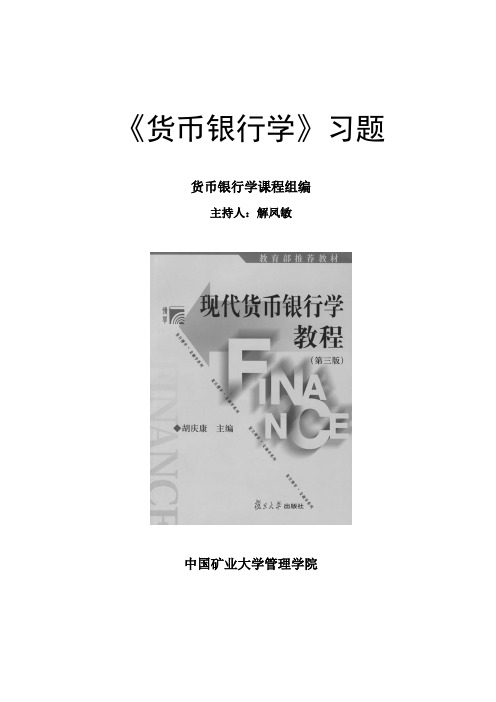
《货币银行学》习题货币银行学课程组编主持人:解凤敏中国矿业大学管理学院第一章货币和货币制度第一部分填空题1.货币是商品生产和商品交换长期发展的产物,在货币产生的过程中,商品价值形式的发展经、、、等四个阶段。
2.是由足值货币向现代信用货币发展的一种过渡性的货币形态,典型代表是。
3.在现代经济中,信用货币存在的主要形式是和。
是新型信用货币形式,是高科技的信用货币。
4.从货币制度诞生以来,经历了、、和五种主要货币制度形态。
5.在商品经济中,货币执行着、、、、五种职能;其中在表现和衡量商品价值时,货币执行职能;在偿还债务时,货币执行职能;在退出流通时执行职能;在世界市场上发挥一般等价物作用时执行职能。
6.流通中所需要的货币量取决于、、等三个因素,它们之间的相互关系可以表示为它们之间的相互关系可以表示为:流通中所需货币量=。
7.货币制度的基本内容包括:、、。
一个国家的基本通货和法定的计价结算货币称为亦称。
8.在格雷欣法则中,实际价值高于法定比价的货币是,实际价值低于法定比价的货币是。
9.金本位制有三种形式:、、,其中只有在流通中使用金币。
10.目前,世界各国普遍以金融资产的强弱作为划分货币层次的主要依据。
狭义货币M1由和构成,广义货币M2由M1加构成。
目前大多数经济学家都接受狭义的货币定义M1,而把其他短期信用工具称为。
第二部分选择题1.物物交换的两个局限性是。
A.供给的双重巧合B.需求的双重巧合C.时间的双重巧合D.商品的双重巧合2.纸币的发行是建立在货币职能基础上的。
A、价值尺度B、流通手段C、支付手段D、储藏手段3.货币职能中,可以采用观念上的货币的是。
A、价值尺度B、流通手段C、贮藏手段D、支付手段4.一件大衣标价10镑金币,其中是价格标准。
A、黄金B、金币C、10D、镑5.一切商品的价值表现在一系列商品上,这被称为。
A.简单的价值形式B.扩大的价值形式C.一般价值形式D.货币形式6.现代经济中的信用货币是纸制的货币符号,货币所有者无论是手持现钞,还是把它存入银行,都发挥了的作用。
国际贸易实务练习13第十四章出口合同的履行

国际贸易实务练习13第十四章出口合同的履行第一篇:国际贸易实务练习13第十四章出口合同的履行第十四章出口合同的履行一、不定项选择题1、信用证的到期地点应视信用证规定而定,在我国外贸实务中,通常使用的到期地点为(D)。
A、出口地B、进口地C、第三地D、开证行所在地2、所谓单证“相符”的原则,是指受益人必须做到(B)。
A、单据与合同相符B、单据和信用证相符C、信用证和合同相符D、修改后信用证与合同相符3、如我方是按样品交货,一旦第三方控告我方,则我方(D)。
A、须承担责任B、不承担责任C、承担一半责任D、视情况而定4、信用证的汇票付款人一般应为(B)。
A、开证行或申请人B、开证行或付款行C、开证行或议付行D、受益人5、当贸易术语采用FOB时,海运提单对运费的表示一般为(B),除非信用证另有规定。
A、Freight PrepaidB、.Freight Collect(运费到付)C、Freight PrepayableD、As Arranged6、按惯例规定,银行开立信用证所产生的一切费用和风险应由(B)负担。
A、受益人B、申请人C、出口公司D、第三方7、在实际业务中,由(B)作为当事人承担审证任务。
A、银行B、银行和出口公司C、出口公司D、第三方8、根据《跟单信用证统一惯例》规定,在金额、数量和单价前有“约”的词语,应解释为有(C)的增减幅度。
A、5%B、7%C、10%D、8% 9.根据《跟单信用证统一惯例》规定,银行有权拒受于装运日期后(A)开提交的单据。
A、21B、15C、30D、6010、在信用证支付方式下,开证行对受益人履行责任,是以(C)A、卖方将货物装运完毕为条件的B、买方收到货物为条件的C、按时收到与信用证相符的全套单据为条件的D、收到卖方提供的代表货物所有权的提单为条件的11、办理出口退税的基本程序是(ACD)。
A、申请B、核销C、上报D、批复E、买单12、采用信用证付款方式签订的CIF合同,卖方履约所包括的环节很多,其中主要的环节有(ABCDE)。
(完整word版)货银题库和答案.doc

第一章货币与货币制度一、名词解释货币信用货币货币制度复本位制平行本位制双本位制金本位制格雷欣法则法定平价布雷顿森林体系牙买加体系二、填空题1.纸币和 ------- 均属于信用货币。
2.货币形态的演进先后经历了------- 、 ------------ 、 ------- 三个发展阶段。
3.法定平价加黄金运送费用,就是黄金----- 点。
法定平价减黄金运送费用,就是黄金-----点。
4.在金属货币制度下,本位币具有---- 、 ------- 和 ------- 特征。
三、选择题1.企业以现金采购原材料时,货币执行的是( B )职能。
A 、价值尺度B 、流通手段C、支付手段D、储藏手段2.信用产生于货币的( C )职能。
A 、价值尺度B 、流通手段C、支付手段D、储藏手段3.辅币具有(BC)特点。
A 、自由铸造B 、限制铸造C、有限法偿D、无限法偿4.“劣币驱良币”现象产生于( C )。
A 、银单本位制B 、平行本位制C、双本位制 D 、金银复本位制5.信用货币的性质是( B C )。
A 、商品货币B 、价值符号C、债务货币D、超物货币6.最不可能作为货币的是( B)。
A 、燕麦B、冰激凌C、香烟D、松香7. 对我国目前发行的 1 元硬币最准确的描述是( A )。
A 、本位币B、金属货币C、实物货币D、辅币8. 在信用发达的国家,占货币供应量最大的是(C)。
A 、纸币B、硬币C、存款货币D、外汇9. 如果金银的法定比价为1:13,而市场比价为1: 15,这时充斥市场的将是( A )。
A 、银币B、金币C、金币和银币 D .都不是10.货币发展的具体形态有(ABCDE )。
A 、实物货币B、金属货币C、兑现的银行券D、支票E、不兑现的银行券四、判断题1.企业用现金向职工发放工资时,货币执行流通手段职能。
F2.金银天然不是货币,但货币天然是金银。
T3.在金属货币制度下,本位币的名义价值大于实际价值。
【精品】货银复习思考题答案.doc
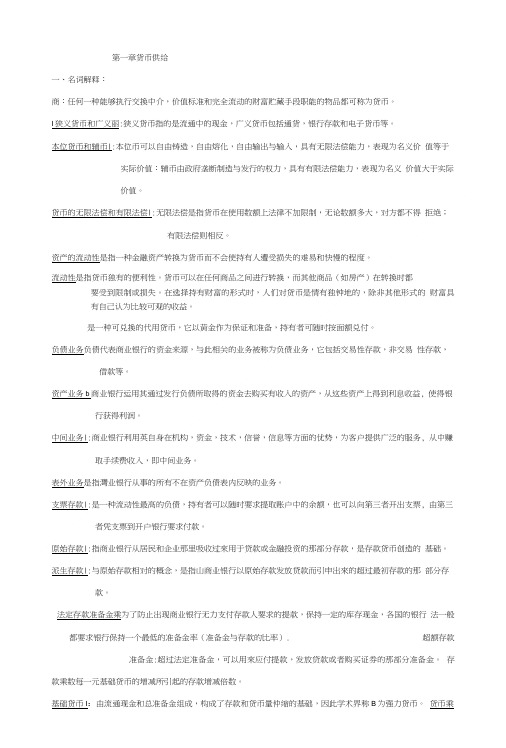
第一章货币供给一、名词解释:商:任何一种能够执行交换中介,价值标准和完全流动的财富贮藏手段职能的物品都可称为货币。
I狭义货币和广义丽:狭义货币指的是流通中的现金,广义货币包括通货,银行存款和电子货币等。
本位货币和辅币|:本位币可以自由铸造,自由熔化,自由输出与输入,具有无限法偿能力,表现为名义价值等于实际价值:辅币由政府垄断制造与发行的权力,具有有限法偿能力,表现为名义价值大于实际价值。
货币的无限法偿和有限法偿|:无限法偿是指货币在使用数额上法律不加限制,无论数额多大,对方都不得拒绝;有限法偿则相反。
资产的流动性是指一种金融资产转换为货币而不会使持有人遭受损失的难易和快慢的程度。
流动性是指货币独有的便利性。
货币可以在任何商品之间进行转换,而其他商品(如房产)在转换时都要受到限制或损失。
在选择持有财富的形式时,人们对货币是情有独钟地的,除非其他形式的财富具有自己认为比较可观的收益。
是一种可兑换的代用货币,它以黄金作为保证和准备,持有者可随时按面额兑付。
负债业务负债代表商业银行的资金来源,与此相关的业务被称为负债业务,它包括交易性存款,非交易性存款,借款等。
资产业务b商业银行运用其通过发行负债所取得的资金去购买有收入的资产,从这些资产上得到利息收益, 使得银行获得利润。
中间业务|:商业银行利用英自身在机构,资金,技术,信誉,信息等方面的优势,为客户提供广泛的服务, 从中赚取手续费收入,即中间业务。
表外业务是指灣业银行从事的所有不在资产负债表内反映的业务。
支票存款|:是一种流动性最髙的负债,持有者可以随时要求提取账户中的余额,也可以向第三者开出支票, 由第三者凭支票到开户银行要求付款。
原始存款|:指商业银行从居民和企业那里吸收过來用于贷款或金融投资的那部分存款,是存款货币创造的基础。
派生存款|:与原始存款相对的概念,是指山商业银行以原始存款发放贷款而引申出來的超过最初存款的那部分存款。
法定存款准备金乘为了防止出现商业银行无力支付存款人要求的提款,保持一定的库存现金,各国的银行法一般都要求银行保持一个最低的准备金率(准备金与存款的比率). 超额存款准备金:超过法定准备金,可以用來应付提款,发放贷款或者购买证券的那部分准备金。
国际贸易单证实务习题册参考答案
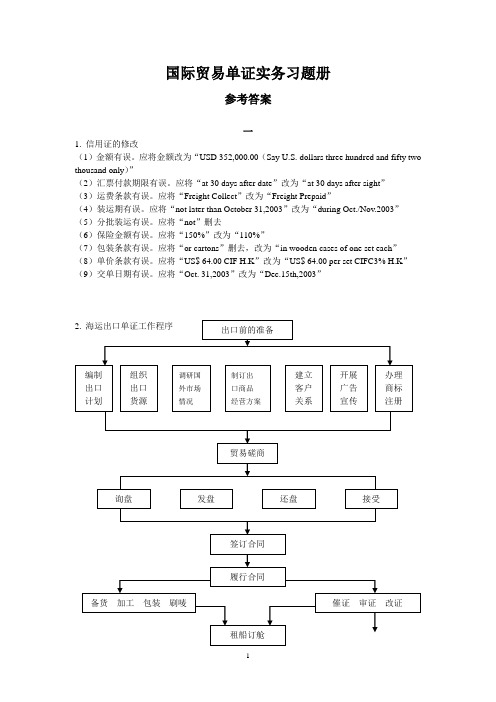
3.collection order
4.remittance
5.remitting bank
6.notary public
7.confirmed irrevocable L/C
8.L/C at sight
ance L/C
10.transferable L/C
TEX. I/E Corp. Ltd.,
Our Ref MQ 83593245
As informed by the drawee that the drawer has agree to reduce the A/M bill amount to USD500,000.00 . Kindly refer the matter to the drawer and confirm by return tested telex whether or not we may pay the new bill amount and deliver the whole document.
Conditions stipulated below:
1.货物名称及规格
Commodity & Specifications
2.数量
Quantity
3.单价
Unit Price
4.总额
Total Value
MAXAM TOOTH PASTE ART.NW101
60000DOZENS
(10000CARTONS)
9.解:
(1)出口商品换汇成本
=7.57 CNY/USD
出口商品盈亏率=9.01%
10.解:
(1)关税完税价格180742 CNY
2020年1月国家开放大学本科《政府经济学》期末纸质考试试题及答案.docx

2020年1月国家开放大学本科《政府经济学》期末纸质考试试题及答案一、单项选择题(每小题1分,共10分)1.政府经济活动的主体是(红色字体为本题正确答案选项).A.各级党委B.各级人大C.各级政协D.各级政府2.(红色字体为本题正确答案选项)是指在市场上存在几个生产厂家,这些企业可以控制某一领域的商品和劳务供给价格,但它们之间还存在一定程度的竞争。
A垄断竞争B.自由竞争C.京头垄断D.完全垄断3.企业在竞争中通过兼并、收购等方式,扩大生产规模和产品市场占有量,当其产量和市场份额足以控制市场价格和供求关系时所产生的垄断属于(红色字体为本题正确答案选项)。
A.天然垄断B.过度竞争产生的垄断C.技术进步产生的垄断D.自然垄断4.按照公共物品的(红色字体为本题正确答案选项)分类,公共物品可分为纯公共物品和准公共物品.A.收益范围B∙性质C.来源D作用5.我国预算年度是(红色字体为本即正确答案选项).A从当年1月1日至12月31日B.从当年4月1日至来年的3月31日U从当年9月1日至来年的8月31日D.从当年11月1日至来年的10月31日6.按照(红色字体为本题正确答案选项)分类,政府支出可分为经常性预算支出和资本性预算支出.A.经济性质B.政府职能C.预算管理体制D预算编制方法7.政府收入按(红色字体为本题正确答案选项)分类,可分为税收收入、债务收入、国有资产收入、行政事业性收费收入、罚没收入、政府性基金收入以及捐赠收入等。
A收入形式8.收入产业部门C.财政管理体制D.收入来源8.按照(红色字体为本题正确答案选项)分类,可将税收收入分为中央税、地方税和共享税.A.税负能否转嫁8.课税对象的性质C税收管理体制D.缴纳税收的形式9.按照(红色字体为本题正确答案选项)分类,公债可以分为有期公债和无期公债.A.发行地域B.债务期限的长短C.公债本位D.应募条件10.按照(红色字体为本题正确答案选项)分类,公债发行方法可以分为直接发行法和间接发行法.A政府在公债发行过程中同应募者之间的联系方式B.公债发行对象C.政府是否通过市场发行公债D∙公债发行规模二、不定项选择题(每小题2分,共10分)11.一个花卉生产企业扩大种植面枳、增加花卉品种,使周围养蜂的蜜蜂有了更多采集花粉的机会,增加了蜂蜜的产量,给养蜂人带来了收益,这种收益属于(红色字体为本题正确答案选项).A∙消费的负外部效应B.生产的负外部效应C.消费的正外部效应D.生产的正外部效应12.下列属于公共投资领域中基础设施投资的是(红色字体为本SI正确答案选项).A.原材料工业B.能源工业C水电煤气设施D.农业投资13.下列属于社会抚恤的是(红色字体为本题正确答案选项).A死亡频B.社会优待C伤残抚恤D.退役安置14.下列属于目前经国务院批)⅛发行的彩票的是(红色字体为本题正确答案选项).A.赛马彩票B.福利彩票D.斗鸡彩票15.下列属于政府决算管理环节的是(红色字体为本题正确答案选项).B.年终清理和结算C政府决算的编制D.政府决算的审查和批准三、判断题(每小Sgl分,共10分)16.政府经济活动仅仅关系到政府路线、方针、政策的执行以及政府职能的实现. [答案]错误17.为解决信息的不对称性对市场机制的干扰,就需要政府干预,通过制定实施有关法律制度,要求交易双方公开公平竞争、等价交换所需的信息,维护市场交易秩序.[答案]正确18.在开放经济条件下,居民和企业具有较大的流动性,地方公共物品的收益边界也是绝对的.[答案储误19.私人物品的公共供给是指政府为了实现宏观经济社会政策目标,生产和供给部分私人物品.[答案]正确20.有外部负效应的商品生产和销售量无法达到资源优化配皆时的市场需求,造成社会资源浪费。
国际货运代理实务习题答案
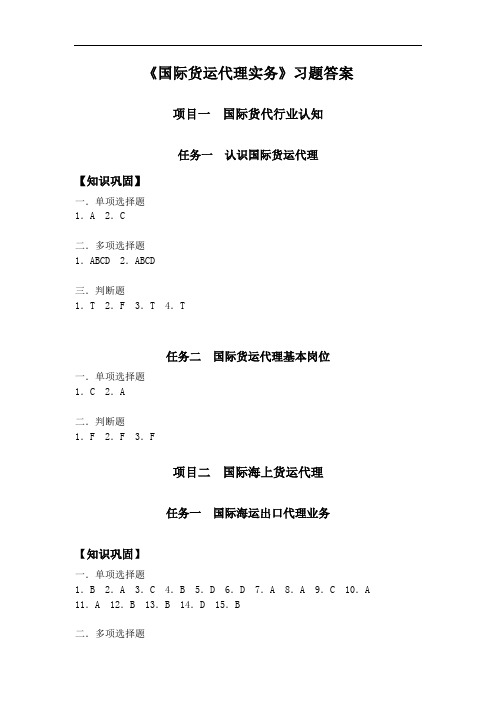
《国际货运代理实务》习题答案项目一国际货代行业认知任务一认识国际货运代理【知识巩固】一.单项选择题1.A 2.C二.多项选择题1.ABCD 2.ABCD三.判断题1.T 2.F 3.T 4.T任务二国际货运代理基本岗位一.单项选择题1.C 2.A二.判断题1.F 2.F 3.F项目二国际海上货运代理任务一国际海运出口代理业务【知识巩固】一.单项选择题1.B 2.A 3.C 4.B 5.D 6.D 7.A 8.A 9.C 10.A 11.A 12.B 13.B 14.D 15.B二.多项选择题1.ABCD 2.ACD 3.BD 4.ABCD 5.ABC 6.AB 7.ABCD 8.ABC 9.ABC 10.BCD三.判断题1.F 2.T 3.F 4.T 5.F 6.F 7.F 8.F 9.T 10.F【能力实训】【能力实训项目1】服装为轻货,按照体积配载N=120/(33.1*80%)=4.53因此需要5个20GP普通干货集装箱【能力实训项目2】(1)072E、074E(2)072E【能力实训项目3】计算集装箱个数货物密度=350/(1.4×1.3×1.1)=174.85千克/立方米集装箱相容利用率80%,20’GP柜的箱容利用率=21740/(33.1×80%)=821千克/立方米,故货物为轻货。
N=(1.4×1.3×1.1×30) /(33.1×80%)=2.27,共需要3个集装箱F=1215×3=3645美元【能力实训项目4】倒签提单是一种违法行为,一旦被识破,产生的后果是严重的。
但是在国际贸易中,倒倒签提单的情况还是相当普遍。
尤其是当延期时间不多的情况下,还是有许多出口商会铤而走险。
当倒签的日子较长的情况出现,就容容易引起买方怀疑,最终可以通过查阅船长的航行日志或者班轮时刻表等途径加以识破。
【能力实训项目5】【能力实训项目6】(1)A贸易公司是托运人,向B货运代理公司提供了正确的货物名称和危险品货物的性质,在这次事故中不承担责任。
国际货运代理上课学习通课后章节答案期末考试题库2023年
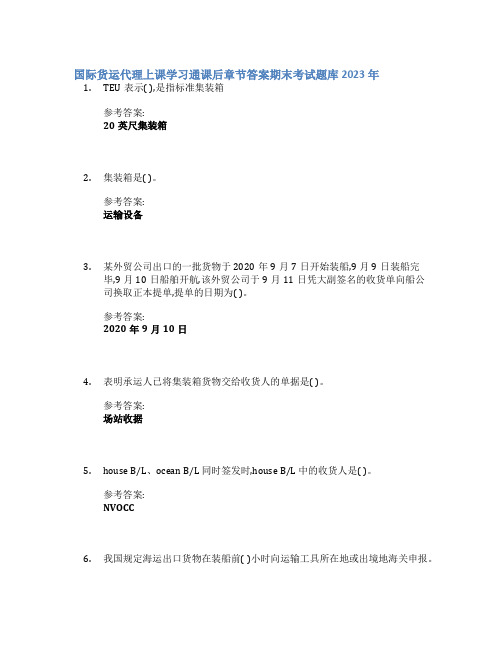
国际货运代理上课学习通课后章节答案期末考试题库2023年1.TEU表示( ),是指标准集装箱参考答案:20英尺集装箱2.集装箱是( )。
参考答案:运输设备3.某外贸公司出口的一批货物于2020年9月7日开始装船,9月9日装船完毕,9月10日船舶开航,该外贸公司于9月11日凭大副签名的收货单向船公司换取正本提单,提单的日期为( )。
参考答案:2020年9月10日4.表明承运人已将集装箱货物交给收货人的单据是( )。
参考答案:场站收据5.house B/L、ocean B/L 同时签发时,house B/L 中的收货人是( )。
参考答案:NVOCC6.我国规定海运出口货物在装船前( )小时向运输工具所在地或出境地海关申报。
参考答案:487.在集装箱出口流程中,托运人委托司机到空箱堆场提取空箱时,设备交接单出场目的与状态栏是( ),当装箱完毕将重箱交回堆场时,进场目的与状态是( )。
参考答案:装船/重箱8.最常用的国际运输方式是( )。
参考答案:海运9.国际货运代理人在签发自己的提单时,他就是( )。
参考答案:承运人10.在集装箱出口运输时,海关必须在场站收据的( )联上加盖放行章才可装船。
参考答案:大副11.提货单是( )。
参考答案:交货凭证12.已知运输条款CY TO CY,提单内容记载装船港、卸船港,该提单是( )。
参考答案:直达海运提单13.订舱单的当事人是( )。
参考答案:托运人与承运人14.提货单的当事人是( )。
参考答案:收货人与承运人15.运输合同的当事人是( )。
参考答案:托运人与承运人16.下列哪张单证是海运集装箱进口货运中特有的单证。
( )参考答案:设备交接单17.国际货运代理人作为进出口货物收、发货人的代理人在安排货物运输事宜时,依照我国相关法律法规的规定,其享有一定的权利并需要承担一定的义务,下列表述不正确的是()。
参考答案:国际货运代理人有向承运人报告委托事务处理情况的义务18.租船合同的当事人是( )。
货银题目
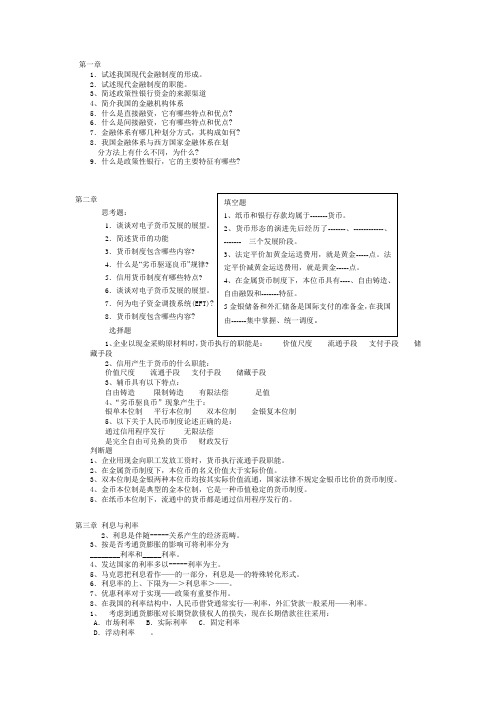
第一章1.试述我国现代金融制度的形成。
2.试述现代金融制度的职能。
3、简述政策性银行资金的来源渠道4、简介我国的金融机构体系5.什么是直接融资,它有哪些特点和优点?6.什么是间接融资,它有哪些特点和优点?7.金融体系有哪几种划分方式,其构成如何?8.我国金融体系与西方国家金融体系在划分方法上有什么不同,为什么?9.什么是政策性银行,它的主要特征有哪些?思考题:1.谈谈对电子货币发展的展望。
2.简述货币的功能3.货币制度包含哪些内容?4.什么是“劣币驱逐良币”规律?5.信用货币制度有哪些特点?6.谈谈对电子货币发展的展望。
7.何为电子资金调拨系统8.货币制度包含哪些内容?选择题1、企业以现金采购原材料时,货币执行的职能是:价值尺度流通手段支付手段储藏手段2、信用产生于货币的什么职能:价值尺度流通手段支付手段储藏手段3、辅币具有以下特点:自由铸造限制铸造有限法偿足值4、“劣币驱良币”现象产生于:银单本位制平行本位制双本位制金银复本位制5、以下关于人民币制度论述正确的是:通过信用程序发行无限法偿是完全自由可兑换的货币财政发行判断题1、企业用现金向职工发放工资时,货币执行流通手段职能。
2、在金属货币制度下,本位币的名义价值大于实际价值。
3、双本位制是金银两种本位币均按其实际价值流通,国家法律不规定金银币比价的货币制度。
4、金币本位制是典型的金本位制,它是一种币值稳定的货币制度。
5、在纸币本位制下,流通中的货币都是通过信用程序发行的。
第三章利息与利率2、利息是伴随-----关系产生的经济范畴。
3、按是否考通货膨胀的影响可将利率分为________利率和_____利率。
4、发达国家的利率多以-----利率为主。
5、马克思把利息看作———的一部分,利息是——的特殊转化形式。
6.利息率的上、下限为——>利息率>———。
7、优惠利率对于实现———政策有重要作用。
8、在我国的利率结构中,人民币借贷通常实行——利率,外汇贷款一般采用———利率。
30道中国古代银票知识选择题和答案

30道中国古代银票知识选择题和答案1. 中国最早的纸币是()。
A. 交子B. 会子C. 关子D. 银票答案:A2. 银票最早出现于()。
A. 唐代B. 宋代C. 元代D. 明代答案:B3. 以下哪个不是古代银票的特点()?A. 便于携带B. 不易伪造C. 可以无限流通D. 有一定的面额答案:C4. 古代银票的发行机构通常是()。
A. 政府B. 钱庄C. 票号D. 商人答案:A5. 以下关于古代银票的使用方法,表述正确的是()。
A. 可以直接用于购买商品B. 需要到指定的机构兑换银子C. 可以在任何地方兑换银子D. 可以用于缴纳赋税答案:B6. 古代银票上通常会有一些特殊的标记或图案,其主要作用是()。
A. 美观B. 防伪C. 代表发行机构D. 无特殊意义答案:B7. 以下哪个不是古代银票的防伪措施()?A. 采用特殊的纸张材料B. 使用复杂的印刷技术C. 加盖官方印章D. 无任何防伪措施答案:D8. 古代银票的面额通常是根据()来确定的。
A. 市场需求B. 商品价格C. 银子的重量D. 政府规定答案:D9. 以下关于古代银票的发展历程,表述正确的是()。
A. 银票的出现标志着货币的发展进入了一个新阶段B. 银票的发展逐渐取代了实物货币的地位C. 随着时代的发展,银票的形制和使用方法也在不断变化D. 以上都是答案:D10. 古代银票的流通范围主要集中在()。
A. 城市B. 农村C. 全国各地D. 商业发达地区答案:D11. 以下关于古代银票的影响,表述正确的是()。
A. 促进了商业的发展B. 方便了人们的日常生活C. 加强了政府对经济的控制D. 以上都是答案:D12. 古代银票的作废通常是由于()。
A. 票面损坏B. 超过有效期C. 政府宣布作废D. 以上都是答案:D13. 以下哪个不是古代银票的收藏价值()?A. 历史文化价值B. 艺术价值C. 经济价值D. 使用价值答案:D14. 古代银票的鉴定方法主要包括()。
国际贸易实务课后答案详解 第十四章 不同结算方式的选择使用

第十四章不同结算方式的选择使用一、思考题1.在国际贸易中,不同结算方式的结合使用,有哪些好处?其具体做法主要有哪几种?试分别说明其作用及基本做法。
答:(1)不同结算方式结合使用的好处在国际贸易中,由于不同的结算方式各有利弊,买卖双方所承担的风险和资金占用的时间各不相同,因此,为了取长补短,做到既能加快资金周转,又能确保收付外汇的安全,以利达成交易,扩大贸易,在同一笔交易中选择两种或两种以上的结算方式结合起来使用是比较有效的做法。
(2)不同结算方式的结合使用①信用证与汇付相结合信用证与汇付结合是指部分货款采用信用证,余额货款采用汇付。
②信用证与托收相结合信用证与托收相结合又称“部分信用证、部分托收”,是指不可撤销信用证与跟单托收两种方式的结合。
一般的做法是:托收采用付款交单方式,出口商在收到信用证经审核无误并装运货物后,要签发两张汇票,一张用于信用证项下的部分货款凭光票支付,另一张随附全部规定的货运单据的跟单汇票,按即期或远期付款交单托收。
③跟单托收与预付押金相结合跟单托收与预付押金相结合是指采用跟单托收并由进口人预付部分货款或一定比率的押金作为保证。
出口人收到预付款或押金后发运货物,并从货款中扣除已收款项,将余额部分委托银行托收。
④备用信用证与跟单托收相结合采用备用信用证与跟单托收相结合的方式,主要是为了在跟单托收项下的货款一旦遭到进口人拒付时,可凭备用信用证利用开证行的保证追回货款,即在备用信用证项下,由卖方开立汇票与签发进口人拒付的声明书要求开证行进行偿付。
2.采用部分信用证、部分托收方式以及备用信用证和托收相结合结算货款的主要作用何在?在实践中应特别注意什么问题?答:(1)部分信用证、部分托收方式相结合的作用及应注意的问题①采用部分信用证、部分托收方式相结合的作用是:对进口人来说,可减少开证金额,少付开证押金,少垫资金;对出口人来说,虽托收部分有一定风险,但有部分信用证的保证,等于预收押金,且货运单据跟随托收汇票项下,开证行须俟进口人付清全部货款后才能放单,所以,出口人的收汇安全就较有保障。
国际货运代理实务学习通课后章节答案期末考试题库2023年
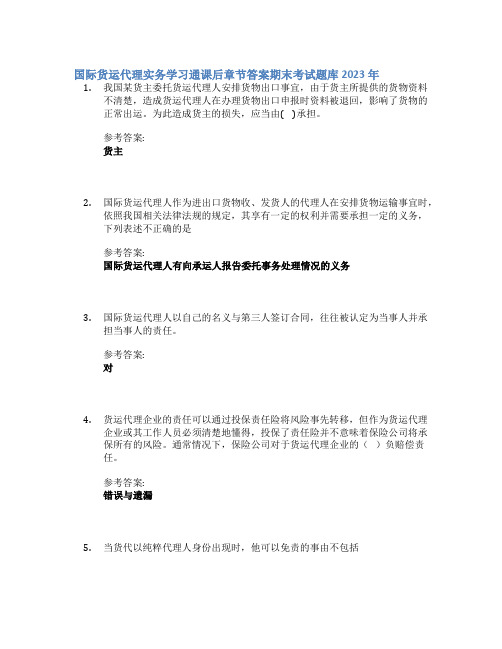
国际货运代理实务学习通课后章节答案期末考试题库2023年1.我国某货主委托货运代理人安排货物出口事宜,由于货主所提供的货物资料不清楚,造成货运代理人在办理货物出口申报时资料被退回,影响了货物的正常出运。
为此造成货主的损失,应当由( )承担。
参考答案:货主2.国际货运代理人作为进出口货物收、发货人的代理人在安排货物运输事宜时,依照我国相关法律法规的规定,其享有一定的权利并需要承担一定的义务,下列表述不正确的是参考答案:国际货运代理人有向承运人报告委托事务处理情况的义务3.国际货运代理人以自己的名义与第三人签订合同,往往被认定为当事人并承担当事人的责任。
参考答案:对4.货运代理企业的责任可以通过投保责任险将风险事先转移,但作为货运代理企业或其工作人员必须清楚地懂得,投保了责任险并不意味着保险公司将承保所有的风险。
通常情况下,保险公司对于货运代理企业的()负赔偿责任。
参考答案:错误与遗漏5.当货代以纯粹代理人身份出现时,他可以免责的事由不包括参考答案:货代在处理货物文件或数据时出现错误造成损失6.在海上货损事故的索赔过程中,索赔方需要出具的单据有参考答案:货运单证###检验证书###商业发票###货物溢短单和残损单7.我国海洋货物运输保险条款包括平安险、水渍险和一切险三种基本险别,这三种基本险别都承保由于自然灾害造成被保险货物的实际全损或推定全损。
参考答案:错8.国际货运代理协会联合会和中国国际货运代理协会均属于政府组织,其宗旨是配合政府部门管理货代行业,维护国际货运代理业正常经营秩序。
参考答案:错9.我国某公司向德国出口一批精致的工艺美术品,装于一个20英尺的集装箱,货物投保了中国人民保险公司海洋运输货物保险条款中的一切险,并加保战争险、罢工险。
根据保险条款的规定,保险人对货物( )的损失不承担赔偿责任。
参考答案:在海上遭遇海盗袭击受损10.某国际货代公司接受货主委托后,以自己的名义到船公司办理了订舱业务,并向保险人投保了货代责任险。
中级经济师(经济基础知识)试题第十四章附答案

第十四章货币供求与货币均衡一、单项选择题1.下列有关货币需求不正确的说法是()。
A.货币需求是指经济主体能够并愿意持有货币的行为B.货币需求是一种主观需求C.货币需求是一种客观需求D.货币需求是一种派生需求2.著名的剑桥方程式是由经济学家()提出的。
A.庇古B.费雪C.凯恩斯D.弗里德曼3.交易动机和预防动机两项构成(),是国民收入的增函数。
A.投机性需求B.普遍性需求C.投资性需求D.交易性需求4.投机性需求的决定因素是()。
A.国民收入B.利率C.物价D.汇率5.能够扩张信用,创造派生存款的金融机构是()。
A.商业银行B.专业银行C.政策性银行D.中央银行6.在我国,广义的货币供应量指的是()。
A.M0B.MlC.M2D.M37.下列属于商业银行负债的是()。
A.现金B.存款C.贷款D.存款准备金8.根据我国货币层次的划分标准,既属于狭义货币供应量(M1),又属于广义货币供应量(M2)的是()。
A.活期存款B.定期存款C.储蓄存款D.财政存款9.凯恩斯认为,完全可以控制货币供应量的行为主体是()。
A.中央银行B.商业银行C.公众D.企业10.有一种观点认为,货币供应量主要由银行和企业的行为所决定,后者又取决于经济体系中的多种变量,而中央银行又不能有效地控制和支配银行、企业的行为,因此货币供应量是内生变量。
提出这种观点的是()A.凯恩斯学派B.货币学派C.新古典综合学派D.新经济自由主义11.货币学派的货币供给理论主要体现在他们对于通货膨胀问题的分析方面,并提出了()。
A.资产组合理论B.“内生货币供应论”的观点C.货币供应量增长率的区间论D.控制货币供应量的“单一规则”12.以下关于货币均衡的叙述中不正确的选项是()。
A.货币均衡是货币供求在动态上保持一致的状态B.货币均衡是—个动态的过程,在短期内货币供求可能不一致C.货币均衡在一定程度上反映了经济总体均衡状况D.货币均衡是货币需求与货币供给在数量上的完全一致13.通货膨胀是价值符号流通条件下的特有现象,其基本标志是()A.物价上涨B.有效需求大于有效供给C.某种商品价格的上涨D.过多的货币追逐过少的商品14.通货膨胀的直接原因是()。
国际商务单证实务操作练习答案

国际商务单证实务操作练习答案第一部分国际商务单证实务分单操作练习项目一信用证分析与审核一、信用证分析练习信用证分析单二、信用证审核练习1.信用证有效期有误,应将050415改为050430;2.信用证金额有误,遗漏币种,应加USD;3.装运港改为SHENZHENG;4.最迟装运日有误,应改为LATEST APR. 15 ,20055.货物描述中遗漏合同号码,应在S/C后加800678;6.47A附加条款中的增减幅度应为3%;7.有关不符点费用两处不同;8.在78处,出现软条款,信用证支付不应由开证申请人来兑付,只要符合信用证规定,银行即应付款。
项目二基本中心单据填制一、发票填制练习一二、商业发票填制练习二三、装箱单填制练习一项目三官方单据申请一、出境货物报检单填制练习中华人民共和国出入境检验检疫出境货物报检单报检单位(加盖公章):*编号报检单位登记号:联系人:电话:报检日期:年月日发货人(中文)诚安茶叶进出口公司(外文)CHENAN TEA IMPORT & EXPORT CORPORATION收货人(中文)(外文)MOMO CO., LTD.货物名称(中/外文) H.S.编码产地数/重量货物总值包装种类及数量普洱茶Pu-erh tea0902.4020云南12,000千克USD26640,00240纸箱运输工具名称号码FENCQING V. 25V.0711********贸易方式一般贸易货物存放地点福州五一路253号合同号HNT(04)021信用证号KUW25847用途外贸自营内销发货日期2004.06.12 输往国家(地区) 日本许可证/审批号启运地福州到达口岸神户生产单位注册号集装箱规格、数量及号码1×20`合同、信用证订立的检验检疫条款或特殊要求标记及号码随附单据(划“✓”或补填)MCL KOBEC/NO.1-240☐✓合同☐信用证☐✓发票☐换证凭单☐✓装箱单☐厂检单☐包装性能结果单☐许可/审批文件☐☐☐☐需要证单名称(划“✓”或补填)*检验检疫费□品质证书□重量证书□数量证书□兽医卫生证书□健康证书□卫生证书□动物卫生证书__正__副__正__副__正__副__正__副__正__副__正__副__正__副□植物检疫证书□熏蒸/消毒证书□✓出境货物换证凭单□□□□__正__副__正__副__正__副总金额(人民币元)计费人收费人报检人郑重声明:1. 本人被授权报检。
2020年金融市场基础知识精选真题及参考答案

2020年金融市场基础知识精选真题及参考答案备考证券从业考试,广大考生们在看书的同时,也要分清主次,把握重要知识点。
证券从业考试栏目为大家分享“2020年金融市场基础知识精选真题及参考答案”,希望对考生们能有所帮助。
想了解关于证券从业考试的讯息,请继续关注我们网站的更新。
2020年金融市场基础知识精选真题及参考答案一、单项选择题1.证券交易市场通常分为( )和场外交易市场。
A.证券交易所市场B.OTC市场C.地方股权交易中心市场D.A股市场【答案】A【解析】证券交易市场分为证券交易所市场和场外交易市场。
2.在Ms=m×B中,m是货币乘数,B是基础货币,Ms是( )。
A.虚拟货币B.货币供给C.名义货币D.货币需求【答案】B【解析】货币供给(量)等于基础货币与货币乘数之积。
即:Ms=m×B,其中,Ms表示货币供给(量);m表示货币乘数;B表示基础货币。
3.下列各项中,属于专门为投资者买卖人民币特种股票而设置的账户是( )。
A.A股账户B.基金账户C.期权账户D.B股账户【答案】D【解析】人民币特种股票账户简称B股账户,是专门用于为投资者买卖人民币特种股票(即B股,也称境内上市外资股)而设置的。
4.优先认股权是指当股份公司为增加公司资本而决定增加发行新的股票时,原普通股股东享有的按其持股比例,以( )优先认购一定数量新发行股票的权利。
A.低于市场价格的任意价格B.高于市场价格C.与市场价格相同的价格D.低于市场价格的某一特定价格【答案】D【解析】优先认股权是指当股份公司为增加公司资本而决定增加发行新的股票时,原普通股股东享有的按其持股比例、以低于市价的某一特定价格优先认购一定数量新发行股票的权利。
5.下列不属于股票特征的是( )。
A.收益性B.风险性C.流动性D.保本性【答案】D【解析】股票具有以下特征:收益性、风险性、流动性、永久性和参与性。
6.对股份有限公司而言,发行优先股票的作用在于可以筹集( )的公司股本。
课程资料:第十四章 课后习题答案

第十四章课后题库参考答案1.欧洲票据市场与欧洲商业票据市场上的区别主要表现在哪些方面?欧洲商业票据与欧洲票据比较起来,最大的区别是前者不需要承销,公司直接对外发行,可节省不少承销费用。
国际公司是欧洲商业票据的主要发行者,欧洲商业票据给国际公司提供了一个非常好的国际债务筹资平台,而且,资信较高的国际公司可以以很低的利率筹措到所需资金。
2.简要评述布雷迪债券发行的背景。
20世纪70年代末,OPEC再次提高石油价格,西方发达国家由于过高的石油价格导致生产成本急剧增加,通货膨胀现象与失业同时并存,滞涨现象出现,于是各国政府通过提高利率等措施实施紧缩的货币政策。
由于西方银行给第三世界国家贷款采用的是浮动利率,随着这些国家世纪利率的不断提高,第三世界国家要偿付给发达国家的利息越来越多,而全球性的经济萧条让第三世界国家经济陷入严重的困境,根本无力偿付越来越多的贷款及其利息,国际债务危机开始出现。
因此在这样的背景下,老布什政府的财政大臣布雷迪被委任制定政策解决国际债务危机问题。
3.美国某国际公司在巴黎通过折价方式发行欧洲商业票据,票据本金总额100 000 000美元,票据发行特点如下:发行3个月的欧洲商业票据40 000 000美元,票面收益为6%,发行6个月的欧洲商业票据60 000 000美元,票面利率为6.5%。
请问,该国际公司共可获得多少资金?该美国国际公司在巴黎通过折价方式发行欧洲商业票据,共获得40 000 000×(1-6%/4)+60 000 000×(1-6.5%/2)=97 450 000美元资金。
4.为何会出现欧洲美元市场?其规模不断扩大的原因是什么?欧洲货币市场的出现最早可以追溯到20世纪50年代。
当时,苏联和东欧的共产主义国家担心美国政府冻结自己拥有的美元存款,而将美元存款存放到巴黎和伦敦的商业银行,从那时候起,存放在美国以外的欧洲美元就产生了。
20世纪80年代初,由于人质危机问题,美国冻结了伊朗存放在美国银行的美元存款,导致中东其他石油输出国将大量存放在美国银行的美元存款转移到西欧国家的银行,欧洲美元规模进一步扩大。
货银第四章纸质练习答案

货币银行学第四章纸质练习姓名:班级:学号:请注意,答案写在下面的方框中,否则判为0分,谢谢合作。
1)Of the following measures of interest rates, which is considered by economists to be the most accurate?(a)The yield to maturity(b)The coupon rate(c)The current yield(d)The yield on a discount basisAnswer:A2)To claim that a lottery winner who is to receive $1 million per year for twenty years has won $20 million ignores the concept of(a)amortizing a loan.(b)par value.(c)deflation.(d)discounting the future.(e)face value.Answer:D3)With an interest rate of 5 percent, the present value of $100 next year is approximately(a)$100.(b)$105.(c)$95.(d)$90.Answer:C4)With an interest rate of 8 percent, the present value of $100 next year is approximately(a)$108.(b)$100.(c)$96.(d)$93.Answer:D5) A security that pays $52.50 in one year and $110.25 in two years, with an interest rate of5 percent, has a present value of(a)$150.(b)$162.50.(c)$200.(d)$300.(e)$400.Answer:A6)Which of the following are true of simple loans?(a)A simple loan requires the borrower to repay the principal and interest at the maturitydate.(b)Commercial loans to businesses are often of this type.(c)The borrower repays the loan by making the same payment every month.(d)Both (a) and (b) of the above.(e)Both (b) and (c) of the above.Answer:D7)If $1102.50 is the amount payable in two years for a $1000 simple loan made today, the interest rate is(a)2.5 percent.(b)5 percent.(c)10 percent.(d)12.5 percent.(e)20 percent.Answer:B8)If $22,050 is the amount payable in two years for a $20,000 simple loan made today, the interest rate is(a)5 percent.(b)10 percent.(c)22 percent.(d)25 percent.(e)205 percent.Answer:A9) A ______ pays the owner a fixed coupon payment every year until the maturity date, when the ______ value is repaid.(a)coupon bond; discount(b)discount bond; discount(c)coupon bond; face(d)discount bond; faceAnswer:C10)Which of the following are true for a coupon bond?(a)When the coupon bond is priced at its face value, the yield to maturity equals thecoupon rate.(b)The price of a coupon bond and the yield to maturity are negatively related.(c)The yield to maturity is greater than the coupon rate when the bond price is below thepar value.(d)All of the above are true.(e)Only (a) and (b) of the above are true.Answer:D11)A consol paying $20 annually when the interest rate is 5 percent has a price of(a)$100.(b)$200.(c)$400.(d)$800.(e)$1000.Answer:C12)If a $10,000 coupon bond has a coupon rate of 5 percent, then the coupon payment every year is(a)$40.(b)$140.(c)$400.(d)$600.(e)none of the above.Answer:E13)Which of the following $1,000 face-value securities has the lowest yield to maturity?(a)A 15 percent coupon bond with a price of $600(b)A 15 percent coupon bond with a price of $800(c)A 15 percent coupon bond with a price of $1,000(d)A 15 percent coupon bond with a price of $1,200(e)A 15 percent coupon bond with a price of $1,500Answer:E14)Which of the following bonds would you prefer to be selling?(a)A $10,000 face-value security with a 6 percent coupon selling for $10,000(b)A $10,000 face-value security with a 6 percent coupon selling for $9,000(c)A $10,000 face-value security with a 6 percent coupon selling for $11,000(d)A $10,000 face-value security with a 7 percent coupon selling for $10,000(e)A $10,000 face-value security with a 7 percent coupon selling for $9,000Answer:C15)A ______ is bought at a price below its face value, and the ______ value is repaid at the maturity date.(a)coupon bond; discount(b)discount bond; discount(c)coupon bond; face(d)discount bond; faceAnswer:D16)Examples of discount bonds include(a)U.S. Treasury bills.(b)U.S. savings bonds.(c)U.S. Treasury notes.(d)all of the above.(e)only (a) and (b) of the above.Answer:E17)Which of the following are true for discount bonds?(a)A discount bond is bought at a price below its face value.(b)The purchaser receives the face value of the bond at the maturity date.(c)U.S. Treasury bonds and notes are examples of discount bonds.(d)All of the above.(e)Only (a) and (b) of the above.Answer:E18)If a $10,000 face-value discount bond maturing in one year is selling for $9,000, then its yield to maturity is(a)9 percent.(b)10 percent.(c)11 percent.(d)12 percent.Answer:C19)Which of the following are true for the current yield?(a)The current yield is defined as the yearly coupon payment divided by the price of thesecurity.(b)The formula for the current yield is identical to the formula describing the yield tomaturity for a consol.(c)The current yield will be a close approximation for the yield to maturity the shorterthe time to maturity, and the closer the bond price to its par value.(d)All of the above are true.(e)Only (a) and (b) of the above are true.Answer:E20)For a bond selling for $4000, with a par value of $5000 and a coupon rate of 10 percent, the current yield is(a)5 percent.(b)10 percent.(c)12.5 percent.(e)25 percent.Answer:C21)The current yield on a $10,000, 10 percent coupon bond selling for $8,000 is(a)10.0 percent.(b)12.5 percent.(c)15.0 percent.(d)17.5 percent.Answer:B22)The current yield on a $10,000, 5 percent coupon bond selling for $5,000 is(a)5.0 percent.(b)7.5 percent.(c)10.0 percent.(d)12.5 percent.Answer:C23)The formula for the measure of the interest rate called the yield on a discount basis has two peculiarities:(a)it uses the percentage gain on the face value of the bill, rather than the percentagegain on the purchase price of the bill.(b)it ignores the time to maturity.(c)it puts the yield on the annual basis of a 360 day year.(d)both (a) and (b) of the above.(e)both (a) and (c) of the above.Answer:E24)A problem with the yield on discount basis is that it __________ the yield to maturity, and this __________ increases, the ___________ the maturity of the discount bond.(a)understates; understatement; longer(b)understates; understatement; shorter(c)overstates; overstatement; longer(d)overstates; overstatement; shorter(e)approximates; approximation; longerAnswer:A25)The yield on a discount basis of a 30-day, $1,000 Treasury bill selling for $950 is(a)5 percent.(b)10 percent.(c)20 percent.(d)50 percent.(e)none of the above.Answer:E26)The yield on a discount basis of a 180-day $1,000 Treasury bill selling for $950 is(b)20 percent.(c)25 percent.(d)40 percent.Answer:A27)When referring to changes in yields, a basis point equals(a)10 percent.(b)1 percent.(c)0.1 percent.(d)0.01 percent.(e)0.001 percent.Answer:D28)Suppose you are holding a 5 percent coupon bond maturing in one year with a yield to maturity of 15 percent. If the interest rate on one-year bonds rises from 15 percent to 20 percent over the course of the year, what is the yearly return on the bond you are holding?(a)5 percent(b)10 percent(c)15 percent(d)20 percentAnswer:C29)If the interest rates on all bonds rise from 5 to 6 percent over the course of the year, which bond would you prefer to have been holding?(a)A bond with one year to maturity(b)A bond with five years to maturity(c)A bond with ten years to maturity(d)A bond with twenty years to maturityAnswer:A30)An equal increase in all bond interest rates(a)increases the price of a five-year bond more than the price of a ten-year bond.(b)increases the price of a ten-year bond more than the price of a five-year bond.(c)decreases the price of a five-year bond more than the price of a ten-year bond.(d)decreases the price of a ten-year bond more than the price of a five-year bond.(e)increases all bond prices by the same dollar amount.Answer:D31)The return on a 10 percent coupon bond that initially sells for $1,000 and sells for $950 next year is(a)-10 percent.(b)-5 percent.(c)0 percent.(d)5 percent.Answer:D32)Which of the following are generally true of all bonds?(a)The only bond whose return equals the initial yield to maturity is one whose time tomaturity is the same as the holding period.(b)A rise in interest rates is associated with a fall in bond prices, resulting in capitallosses on bonds whose terms to maturity are longer than the holding periods.(c)The longer a bond’s maturity, the greater is the size of th e price change associatedwith an interest rate change.(d)All of the above are true.(e)Only (a) and (b) of the above are true.Answer:D33)The riskiness of an asset’s returns due to changes in interest rates is(a)uncertainty.(b)price risk.(c)asset risk.(d)interest-rate risk.(e)exchange-rate risk.Answer:D34)If you expect the inflation rate to be 15 percent next year and a one-year bond has a yield to maturity of 7 percent, then the real interest rate on this bond is(a)7 percent.(b)22 percent.(c)-15 percent.(d)-8 percent.(e)none of the above.Answer:D35)When the interest rate on a Treasury Inflation Protected Security is 3 percent, and the yield on a nonindexed Treasury bond is 8 percent, the expected rate of inflation is(a)3 percent.(b)5 percent.(c)8 percent.(d)11 percent.(e)24 percent.Answer:B。
《金融基础知识》第14章课后习题答案

用心用情品质文档精品行业资料,仅供参考,需要可下载并修改后使用!《金融基础知识》课后习题答案第14章习题答案1.标准化成本、交易成本和市场影响成本。
2.因为交易所提供的衍生产品一般有专门的清算所,客户不是直接从期权的卖方那里购买期权,清算所是期权卖方和买方的中介。
因此,如果期权的卖方违约,一般对买方不会有什么影响,清算所的资本金一般足以保证客户到期获得偿付。
由于清算所的资本金有差异,因此有破产倒闭的可能,但可能性比较小,所以客户从交易所购买产品面临的违约风险比较小。
3.不能,因为虽然交易所关闭几个小时甚至几天都可能性很小,但当存在严重的信息不对称的时候某种金融工具停止交易的可能性很大。
例如NYSE详细规定了停止某只股票交易的程序。
其它交易所,特别是期货交易所存在涨跌停板的限制。
还有在没有任何人想交易的时候,交易也就停止了。
因此交易所提供某个金融产品,并不意味着你随时能够随意地在交易所买入或卖出。
4.信用风险、其他于交易伙伴有关的风险、价格的透明度问题以及头寸中途冲销会面临困难。
5.在产品不存在又没有其他替代品的时候动态复制策略是个很好的选择,它可以实现有效的保值。
同时在产品很贵的时候,动态复制策略也可以降低保值成本。
此外运用动态复制策略的匿名性和保密性更好。
这样可以尽量避免将自己的信息暴露给竞争对手。
不过动态复制策略可能面临交易频率可能很高、流动性不足、模型风险和执行风险的问题。
6.一般静态复制策略的交易频率低,而且没有模型风险。
7.我们将买入或卖出回报和公司想要规避的风险相关的证券的做法称为内嵌衍生工具法。
8.一部分原因是金融创新面临的需求曲线是不确定的。
如果产品的需求比预计的低,那么产品就失败了。
这会影响发行公司的声誉和开发新产品的能力。
因此公司在初始发行的时候在价格上做出一定的让步以了解市场需求信息是可以理解的。
初始发行折价也有其它能够带来利润的原因,因为投资对新产品了解不多,他们必须全面地了解产品看看是否应该投资,因此投资者可能会以为等等看更有利可图,为了吸引投资者,发行者会在价格上做出一定的让步。
- 1、下载文档前请自行甄别文档内容的完整性,平台不提供额外的编辑、内容补充、找答案等附加服务。
- 2、"仅部分预览"的文档,不可在线预览部分如存在完整性等问题,可反馈申请退款(可完整预览的文档不适用该条件!)。
- 3、如文档侵犯您的权益,请联系客服反馈,我们会尽快为您处理(人工客服工作时间:9:00-18:30)。
货币银行学第七章纸质练习姓名:班级:学号:请把选择题答案(大写字母)填入框内。
Multiple Choice1)Money supply models tend to focus on the monetary base rather than on reserves since(a)Fed actions have no effect on reserves but have a predictable effect on the monetary base.(b)Fed actions in general have little effect on reserves but have a predictable effect on the monetarybase.(c)Fed actions have a more predictable effect on the monetary base.(d)none of the above.2)The ratio that relates the change in the money supply to a given change in the monetary base is calledthe(a)money multiplier.(b)required reserve ratio.(c)deposit ratio.(d)discount rate.3)The formula linking the money supply to the monetary base is(a)M = m/MB.(b)M = m ⨯ MB.(c)m = M ⨯ MB.(d)MB = M ⨯ m.(e)M = m + MB.4)The variable that reflects the effect on the money supply of changes in factors other than themonetary base is the(a)currency-checkable deposits ratio.(b)required reserve ratio.(c)money multiplier.(d)nonborrowed base.5)The equation linking the monetary base to the levels of checkable deposits and currency is(a)MB = R + C.(b)MB = (r ⨯ D) + ER.(c)MB = (r ⨯ D) + ER + C.(d)both (a) and (b) are correct.(e)both (a) and (c) are correct.6)The equation linking the monetary base to the levels of checkable deposits and currency is(a)MB = (r ⨯ D) + ER + C.(b)MB = (r + D) + ER + C.(c)MB = (r/D) + ER + C.(d)MB = (r – D) + ER – C.(e)MB = (r ⨯ D) – ER – C.7)During the Christmas holiday season, depositors typically withdraw more currency from theiraccounts. This implies that(a)the money multiplier falls during the Christmas season.(b)the money multiplier rises during the Christmas season.(c)discount borrowing falls during the Christmas season.(d)excess reserves fall during the Christmas season.(e)none of the above occur.8)The formula for the money multiplier that includes excess reserves and currency is(a)m = (1+c)/(r + e + c).(b)M = 1/(r + e + c).(c)M = (1 + c)/(r + e + c).(d)D = 1/(r + e + c).(e)m = (1/(r + e + c)) ⨯ MB.9)The formula for the money supply that includes excess reserves and currency is(a)m = 1/(r + e + c).(b)D = 1/(r + e + c).(c)M = (1 + c)/(r + e + c).(d)D = (1/(r + e + c)) ⨯ MB.(e)M = ((1 + c)/(r + e + c)) ⨯ MB.10)If the required reserve ratio is 10 percent, currency in circulation is $400 billion, checkable depositsare $800 billion, and excess reserves total $0.8 billion, then the currency ratio is(a).25.(b).50.(c).40.(d).05.11)If the required reserve ratio is 10 percent, currency in circulation is $400 billion, checkable depositsare $800 billion, and excess reserves total $0.8 billion, then the monetary base is(a)$480 billion.(b)$480.8 billion.(c)$80 billion.(d)$80.8 billion.12)If the required reserve ratio is 15 percent, currency in circulation is $400 billion, checkable depositsare $1000 billion, and excess reserves total $1 billion, then the money multiplier is approximately(a)2.55.(b)2.67.(c)2.35.(d)0.551.13)Because an increase in the monetary base will mean an increase in the level of currency incirculation,(a)the actual money multiplier will be smaller than the simple deposit multiplier.(b)a given change in the monetary base will lead to a smaller increase in checkable deposits thanindicated by the simple deposit multiplier.(c)a given change in the monetary base will lead to a larger increase in checkable deposits thanindicated by the simple deposit multiplier.(d)both (a) and (b) of the above will occur.14)The money multiplier is smaller than the simple deposit multiplier when(a)the excess reserves ratio is zero.(b)the currency–checkable deposit ratio is zero.(c)the excess reserves ratio is greater than zero.(d)only (a) and (b) of the above are true.15)Assuming initially that r = 10%, c = 40%, and e = 0, an increase in r to 15% causes(a)the money multiplier to increase from 2.55 to 2.8.(b)the money multiplier to decrease from 2.8 to 2.55.(c)the money multiplier to increase from 1.82 to 2.(d)the money multiplier to decrease from 2 to 1.82.(e)no change in the money multiplier.16)For a given level of the monetary base, an increase in the currency ratio causes the money multiplierto _____ and the money supply to _____.(a)decrease; increase(b)increase; decrease(c)decrease; decrease(d)increase; increase17)The excess reserves ratio is _____ related to expected deposit outflows, and is _____ related to themarket interest rate.(a)negatively; negatively(b)negatively; positively(c)positively; negatively(d)positively; positively18)Factors that cause the excess reserves ratio to fall include:(a)a decline in expected deposit outflows.(b)a rise in market interest rates.(c)a decline in market interest rates.(d)only (a) and (b) of the above.(e)only (a) and (c) of the above.19)Factors that cause a decline in the money multiplier include:(a)a lowering of the required reserve ratio.(b)a decrease in the market interest rate.(c)an increase in expected deposit outflows.(d)only (b) and (c) of the above.20)The Fed does not completely control the monetary base because(a)it cannot set the required reserve ratio on checkable deposits.(b) it cannot perfectly predict the amount of discount borrowing by banks.(c) it cannot perfectly predict shifts from deposits to currency.(d) of each of the above.(e) of both (a) and (b) of the above.21) The relationship between discount loans, the nonborrowed monetary base, and the monetary base is(a) MB = MB n – DL.(b) DL = MB n – MB.(c) DL = MB – MB n .(d) MB = DL - MB n .(e) MB n = MB + DL.22) The Fed lacks complete control over the money supply because it cannot perfectly predict(a) the amount of discount borrowing by banks.(b) shifts from deposits to currency.(c) the level of excess reserves held by banks.(d) any of the above.23) Equal increases in the discount rate and market interest rates cause banks to(a) hold fewer excess reserves.(b) increase discount borrowing from the Fed.(c) decrease discount borrowing from the Fed.(d) do both (a) and (b) of the above.24) Factors that cause an increase in the money supply include:(a) a decline in the discount loan rate.(b) a decline in market interest rates.(c) an increase in expected deposit outflows.(d) only (a) and (b) of the above.25) Which of the following is the most important determinant in explaining movements in the moneysupply over time?(a) Changes in the required reserve ratios(b) Changes in the discount rate(c) Changes in the currency ratio(d) Changes in the nonborrowed monetary baseEssay Questions1) Explain the complete formula for the money supply, and explain how changes in required reserves,excess reserves, the currency ratio, the nonborrowed base, and discount borrowing affect the money supply.Answer: The formula isn 1c M (MB DL)r c e+=⨯+++The formula indicates that the money supply is the product of the multiplier times the base.Increases in any of the multiplier components, required reserves, r; excess reserves, e; orthe currency ratio, c, reduce the multiplier and the money supply. Increases in thenonborrowed base and discount borrowing both increase the base and the money supply.选择题答案1~5 CABCE6~10 AAAEB11~15 BADCB16~20 CCDDB21~25 CDAAD。
